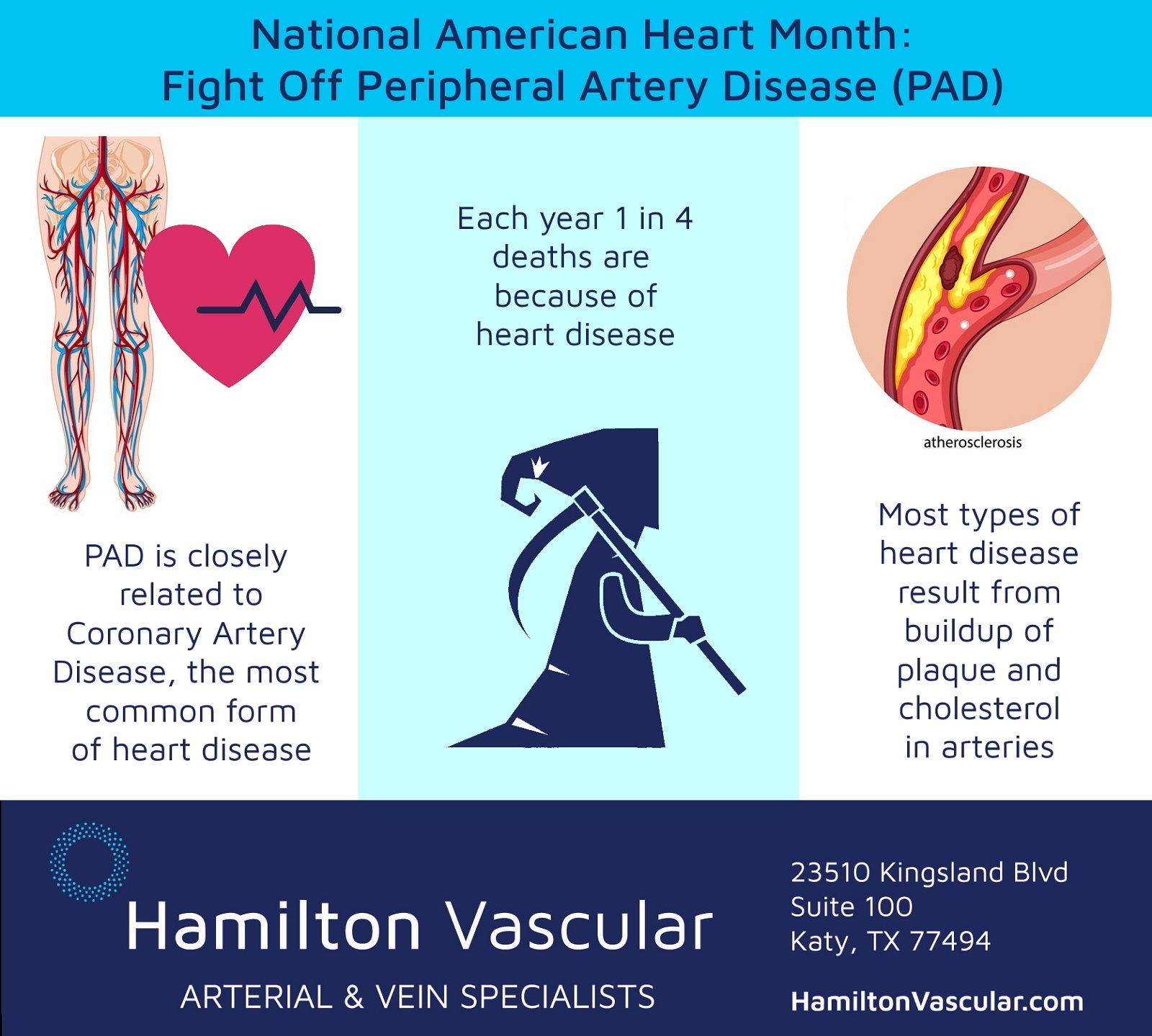Miriam’s eyes light up, and a big smile slowly stretches across her face every time the calendar flips to February. All month long, heart attack survivors like Miriam observe American Heart Month, an initiative designed to keep everyone aware of both the obvious and silent dangers of heart disease. Miriam is particularly interested in peripheral artery disease (PAD) awareness efforts, as past struggles with PAD ultimately led to her heart attack.
PAD, also known as arteriosclerosis, is a vascular condition characterized by plaque buildup on the walls of the major blood vessels or arteries, causing them to narrow. It affects 8.5 million U.S. adults and 113 million people worldwide. If left unchecked, it can put someone at a higher risk of coronary artery disease, heart attack, and stroke.

The good news is that heart disease and peripheral artery disease can be prevented with a healthy lifestyle and routine doctor visits. And with the right vascular specialist, PAD can be diagnosed and treated to avoid complications.
Questions about your risk for PAD? Call 832-886-0123 to schedule a consultation with Hamilton Vascular’s arterial experts in Katy, Texas. Appointment
Why American Heart Month Matters for Arterial Patients
At Hamilton Vascular, we agree it is important to educate patients through critical public awareness efforts such as American Heart Month. Per the Centers for Disease Control and Prevention (CDC), heart disease is the leading cause of death for men, women, and people of most racial and ethnic groups in the United States. In fact, about 659,000 people in the U.S. die from heart disease each year, and the annual cost has risen to $363 billion. American Heart Month is a way to get people talking about heart disease risks and how to properly avoid them. Examples of heart disease risks include:
- High blood pressure and high cholesterol
- Excessive smoking
- Not getting enough physical activity (sedentary lifestyle)
- A bad diet
- Being overweight or obese
While our vascular experts do not specifically treat the heart, we are the premier facility for properly diagnosing and treating other vascular diseases and conditions that can ultimately lead to heart disease. This includes peripheral artery disease (PAD). You see, our veins and arteries are a very intricate internal highway that allows blood to flow to and from the heart and throughout our body. When everything is working as it should, there are no problems. But this isn’t always the case for many people, especially as we get older. Over time, our veins can become diseased, and our arteries become clogged with dangerous plaque. As a result, critical blood flow is drastically limited or impeded entirely.
PAD in its most severe form of “no blood flow” is called critical limb ischemia (CLI). It can trigger a heart attack if the arteries that supply blood to your heart are blocked and the plaque ruptures. It can also result in possible leg amputation. Signs that you have poor blood circulation issues because of PAD include:
- Painful cramping in legs or hips when active but not a rest
- Numbness in feet or toes
- Changes in appearance of extremities (discoloration, loss of hair, shiny skin)
- Cold legs and feet
- Thickening toenails
- Open sores or ulcers that don’t heal
- No pulse or weak pulse in legs and feet
- Dry, discolored skin on the legs and feet
Interestingly, the CDC says that up to 4 in 10 people with PAD don’t have symptoms. But in almost every case, sluggish blood flow caused by PAD will progress from no symptoms to varying leg pain.

Searching for a peripheral artery disease doctor in the Katy and Greater Houston area? Request a visit with Hamilton Vascular’s arterial experts in Katy, Texas. Appointment
How to Properly Treat and Improve Heart Health
When it comes to American Heart Month and peripheral artery disease, it’s important now more than ever to treat vascular disease as early as possible. If you suspect your symptoms are peripheral artery disease related, a vascular specialist at Hamilton Vascular can help. An assessment and testing can help your doctor understand how severe your condition is and suggest a treatment plan that fits your needs.
Use this easy PAD checklist to prepare for your doctor visit. Download Checklist
Depending on the outcome of diagnostic tests, your specialist may also suggest minimally invasive treatments. Below are a few options:
- Angioplasty — Often recommended to PAD patients, this balloon system opens narrowed or blocked arteries. A catheter is inserted through a small incision and advanced to the affected artery. There is minimal downtime.
- Atherectomy — This procedure uses advanced laser technology to erase plaque buildup in the arteries. It can be performed on its own but is often combined with angioplasty and stenting.
- Stenting — A more advanced procedure, this involves using a small mesh tube to keep a closed-off blood vessel or artery open for the long term. This procedure greatly reduces the chance of a reoccurring blockage.
Beyond visiting with a vascular specialist, living a healthy lifestyle can help you avoid peripheral artery disease and heart disease. Here are examples of healthy living choices to start this month and continue throughout the include:
- Choose healthier eating habits — Eating better and improving your diet plays a huge role in maintaining blood circulation, losing weight, and improving cardiovascular health. Options include fruits and vegetables, foods high in Vitamin C and E, and fiber-rich foods.
- Get more exercise — Exercising regularly helps improve blood flow throughout the body, builds strong muscles and joints, and simply promotes a healthier lifestyle. For adults, the American Heart Association recommends at least 150 minutes per week of moderate-intensity aerobic activity and to increase the amount and intensity gradually.
- Quit smoking — Smoking, in general, is not good for you and is the leading cause of preventable disease and death in the United States, per the CDC. This includes its direct impact on the formation of varicose veins and other venous diseases and complications.
Hamilton Vascular Supports American Heart Month and Peripheral Artery Disease
It’s important to recognize peripheral artery disease early and seek help from a medical professional who can guide you on your next steps. Hamilton Vascular has long been a leader in performing leading-edge procedures to treat arterial conditions such as PAD—all while providing compassionate patient care. The vascular physicians at Hamilton are board-certified diagnostic radiologists with additional fellowship training in vascular and interventional radiology.
For a consultation with one of our expert arterial doctors, please contact us or complete the appointment form.
23510 Kingsland Blvd Suite 100
Katy, TX 77494
Phone: 866-552-4866
Prior to starting any new treatment or questions regarding a medical condition, always seek the advice of your doctor or other qualified health provider. This information is not a substitute for professional medical advice.
Hamilton Vascular serves the South Texas area including Houston, San Antonio, Austin, Round Rock, Bastrop, Brushy Creek, Cedar Park, Converse, Georgetown, Hutto, Kyle, League City, Leander, Marble Falls, New Braunfels, Pasadena, Pearland, Pflugerville, San Marcos, Schertz, Sugar Land, The Woodlands, Universal City and more.

